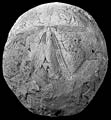The Echinoid Directory
Sandiegoaster Sanchez Roig, 1952, p.12
| Diagnostic Features |
|
|---|---|
| Distribution | Mid to Late Eocene, Cuba. |
| Name gender | masculine |
| Type | Sandiegoaster durhami, Sanchez Roig, 1952, p. 12, by original designation. |
| Species Included |
|
| Classification and/or Status |
|
| Remarks |
|



